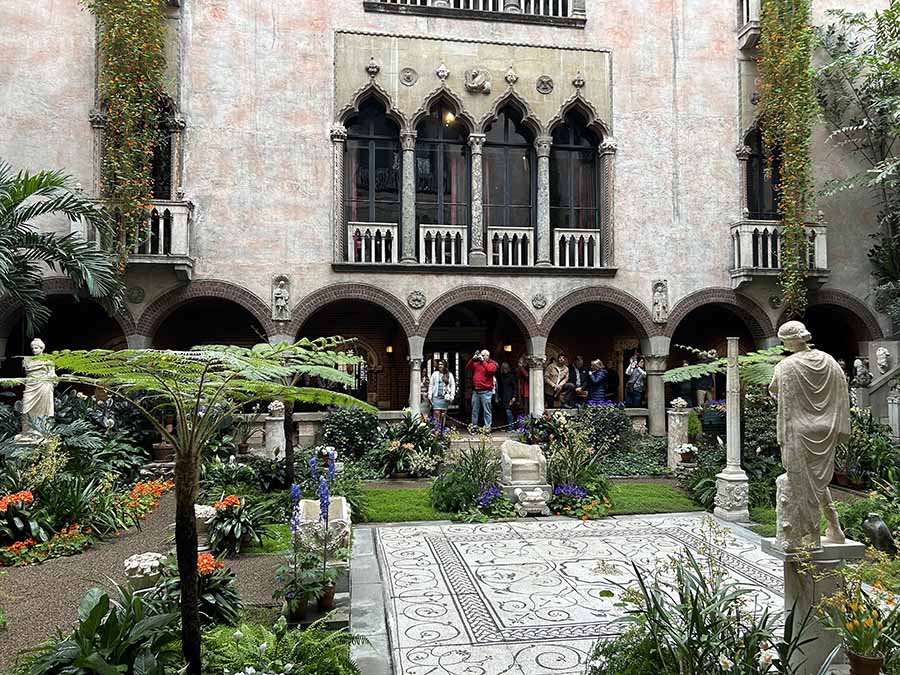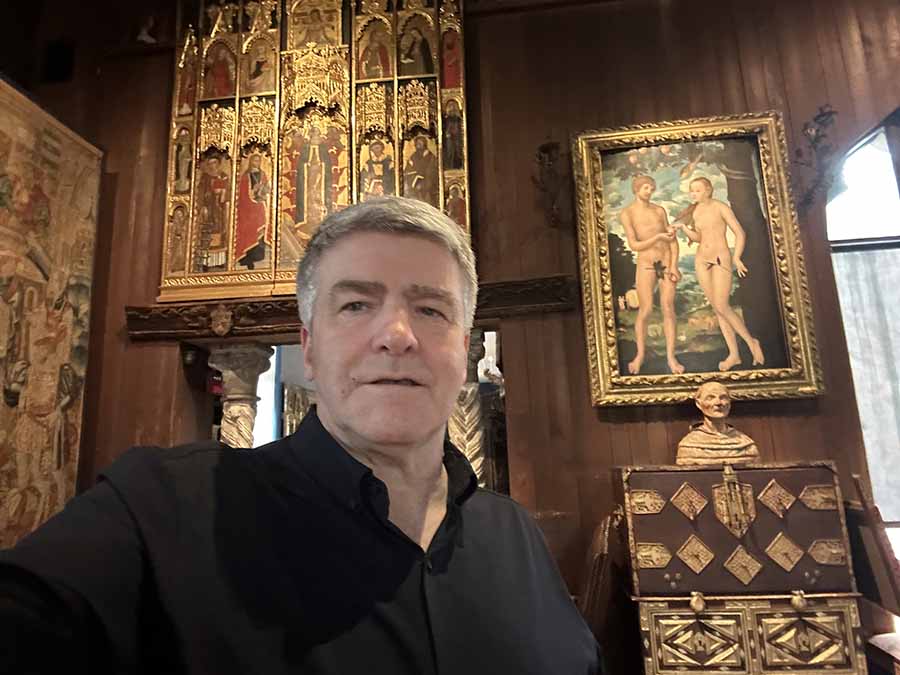
Here’s a not-so-hidden gem, but one that does not reveal all its plume at first glance to the international visitor, or, indeed, if you approach it from the outside.
The Isabella Stewart Gardner Museum in Boston is a singular gem, a world-renowned art museum and cultural landmark, celebrated for its eclectic collection, Venetian-inspired architecture, and lush courtyard, about 2.5 miles from Beacon Hill Books & Cafe.
It is distinct from traditional museums due to its intimate, eclectic nature and the fascinating story of its founder, Isabella Stewart Gardner. Housed in a Venetian-style palazzo, it’s as much a work of art as the collection it holds. Here’s what sets it apart and what you should see:
Unlike encyclopedic museums, the Gardner reflects Isabella’s idiosyncratic taste. She personally curated the collection and designed the space, blending art, furniture, and architecture into a cohesive experience.
Over 7,500 artworks span 2,000 years in the , from ancient Rome to 19th-century America, valued at $1bn. Highlights include European masterpieces, American art, and Asian artifacts, reflecting Gardner’s global travels with her husband, Jack.
Completed in 1903, Fenway Court (as she called it) mimics a 15th-century Venetian palace, with a stunning central courtyard filled with lush greenery, Roman mosaics, and seasonal blooms—a rare indoor-outdoor fusion.
Per Isabella’s will, the collection remains as she left it in 1924, with no labels or rearrangements, creating a time-capsule feel that’s both charming and mysterious.
The 1990 theft of 13 artworks (including masterpieces by Vermeer and Rembrandt) remains unsolved, and empty frames still hang as a haunting reminder, adding intrigue to the visit.
Modeled after a 15th-century Venetian palazzo, the museum’s exterior is understated brick, but its interior dazzles with a four-story atrium. Designed with architect Willard T. Sears, it integrates elements from European structures like Florence’s Palazzo Barbaro.
Designed by Isabella and later Frederick Law Olmsted Jr., it features Roman mosaics, Venetian arches, and plants like orchids and hydrangeas, creating a serene oasis.
The lack of labels encourages personal discovery—bring a guidebook or use the museum’s audio tour to decode the treasures.
The New Wing often features contemporary artists responding to Isabella’s legacy, like Sophie Calle’s installations tied to the heist.
If you visit in spring, as we did, look out for the famous nasturtiums cascading from balconies of the courtyard, a tradition Isabella started, a horticultural masterpiece blooming year-round with seasonal displays (e.g., nasturtiums in spring, poinsettias in winter).
Three floors of intimate galleries surround the courtyard, filled with architectural fragments (e.g., medieval doorways, columns) and art displayed in Gardner’s idiosyncratic style—unlabeled, eclectic, and personal, evoking a private home rather than a traditional museum.
The Gardner Museum feels like stepping into a collector’s dream, where every corner reveals Isabella’s bold personality. It’s smaller than the Museum of Fine Arts, which we visited on the same day, but no less captivating—perfect for those who love art with a story. Just don’t touch anything; Isabella’s will forbids it.
Things to check out:
- The Courtyard: The heart of the museum, this glass-roofed atrium is a masterpiece of light and texture, framed by arches and filled with ancient sculptures, tiles, and ever-changing floral displays. It’s a tranquil oasis that ties the galleries together.
- Notable Work include Titian’s Europa (1560–62, one of the world’s finest Renaissance paintings), Botticelli’s Virgin and Child with an Angel (1470s), Rembrandt’s Self-Portrait, Age 23 (1629), and Vermeer’s The Concert (1664, stolen in 1990), John Singer Sargent’s El Jaleo (1882) and a portrait of Gardner (1888), plus works by Whistler and Cassatt.
- Other exhibits include ancient Egyptian sarcophagi, Japanese screens, medieval manuscripts, and 1,500 rare books, including Dante’s Divine Comedy (1481).
European Masterpieces:
- Titian’s Europa (Room: Titian Room): One of his greatest works, The Rape of Europa (1562), dazzles with its vivid colors and dynamic composition.
- Raphael’s Pietà: A tender, early work by the Renaissance master in the Early Italian Room.
- The Empty Frames: In the Dutch Room, see the vacant spots where Vermeer’s The Concert and Rembrandt’s The Storm on the Sea of Galilee once hung—eerie relics of the heist.
- Giotto’s Presentation of the Infant Jesus: A rare panel painting by the proto-Renaissance genius, glowing with gold and emotion (Early Italian Room).
- Sandro Botticelli: His Madonna and Child exemplifies Florentine grace.
Eclectic Treasures:
- John Singer Sargent’s El Jaleo: A massive, dramatic painting of a Spanish dancer, displayed in the Spanish Cloister with theatrical flair.
- Textiles and Furniture: Isabella’s love for the decorative arts shines in tapestries, ornate chairs, and even her personal letters scattered throughout.
- The Gothic Room: Once Isabella’s private retreat, this moody space features Sargent’s controversial portrait of her (1888), alongside medieval stained glass and reliquaries. It’s only viewable from a balcony, adding to its mystique.
- The New Wing: Designed by Renzo Piano in 2012, this modern addition contrasts the historic palace. It houses a small gallery for rotating exhibits, a concert hall (hosting chamber music), and Calderwood Hall with its striking acoustics.

Personal favourite
My personal favourite is Adam and Eve, by a follower of Lucas Cranach the elder (Kronach, Bavaria, 1472 – 1553, Weimar, Thuringia) Adam and Eve Adam and Eve was one of the first works by an old master that Isabella Gardner purchased. She bought it in 1892 as a painting by Lucas Cranach, but since then scholars have disputed that attribution.
Some say the figures may have been painted by Cranach; others feel they are too sweetly portrayed and must be by another, less-talented artist. Also, no other known Cranach paintings include such large areas of sky or landscapes that appear to recede into space, as this one does. Is this a painting begun by Cranach and then finished or reworked by a student or assistant? Or is it by a later imitator?
DNE 2025 in Rhode Island: the Fam trip
Links: Discover New England tourism forum – DNE media panel discussion –
Boston city – Afternoon tea in Boston library – Boston Museum of Fine Art – China Pearl, in Boston’s Chinatown – View Boston panoramic tower
Hartford, Connecticut – Madison, Connecticut – Mashantucket Pequot Museum – Mystic Seaport Museum – Mystic, Connecticut – New Bedford, Massachusetts – New Haven Connecticut – Newport, Rhode Island – South Eastern Massachusetts – Westerly, Rhode Island




